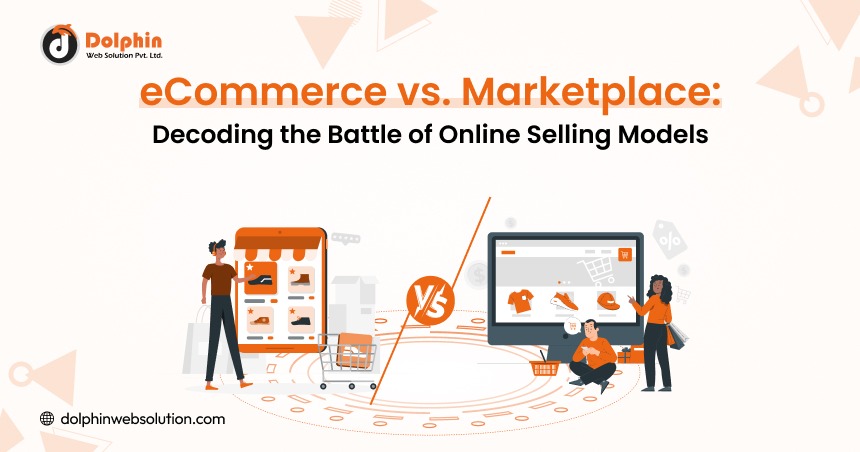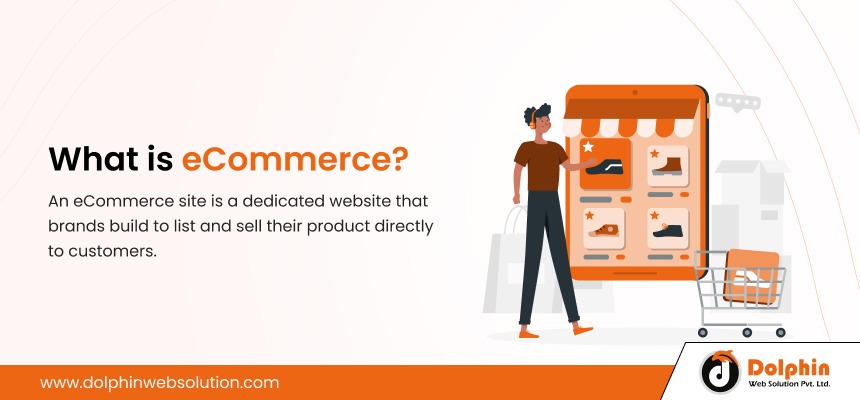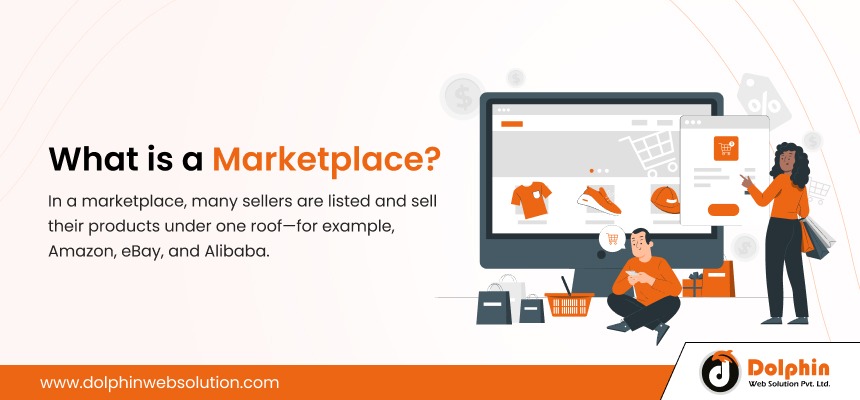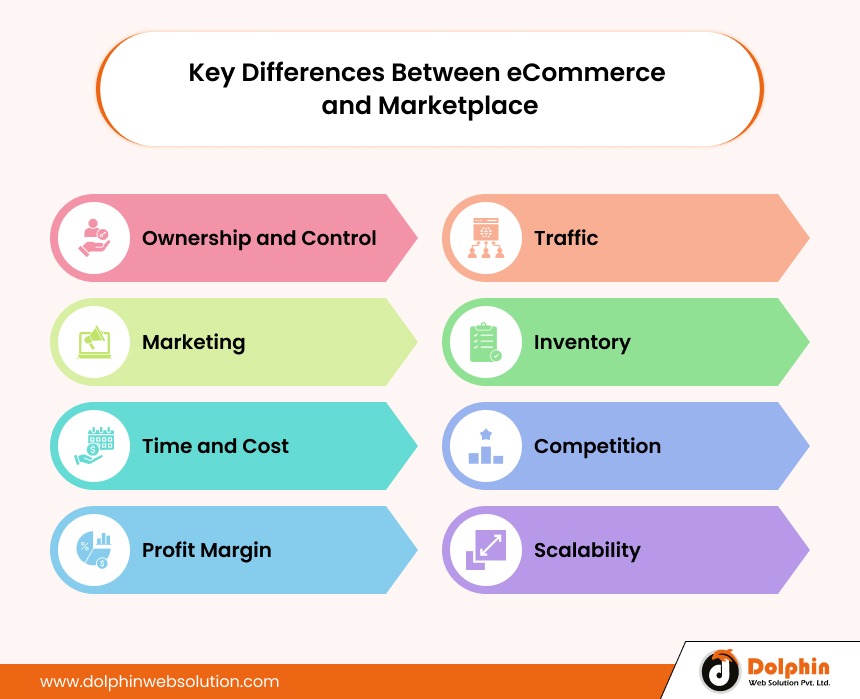eCommerce vs. Marketplace: Decoding the Battle of Online Selling Models

Table of Contents
Summary :
Deciding between an eCommerce site and a marketplace depends on business needs. An eCommerce offers complete control, customer experience, and profits. On the other hand, the marketplace is quicker to set up with large audiences. This blog helps you find out which model is suitable for your business.
Whenever a brand plans to sell its product online, there are only two ways, i.e., eCommerce site or marketplace.
Building a custom eCommerce website allows brands to sell their products and get complete control over marketing, direct custom targeting, and order processing. On the other hand, some brands can list their product on marketplaces like Amazon, from warehousing, logistics, shipping, and customer service will manage everything.
Depending on business needs, both have different ways of selling the brand’s products.
Which option suits your brand better, and how can you pick the right one?
In this blog, we will understand both eCommerce sites and the marketplace, the key differences between them, the pros and cons of each, and which one is better for your brand.
What is eCommerce?

An eCommerce site is a dedicated website that brands build to list and sell their product directly to customers. This approach is rapidly adapting, and most brands are now focusing on cutting intermediaries and creating their D2C eCommerce website to get complete control over operations and profit margins with future scalability—various eCommerce platforms, like Shopify, Wix, and WooCommerce. Allow brands to build their online store and sell their products globally quickly.
What is a Marketplace?

In a marketplace, many sellers are listed and sell their products under one roof—for example, Amazon, eBay, and Alibaba. So many sellers have listed their products with a wide range of variety in one place. Customers visit these marketplaces, find their desired product, and buy it from the seller offering it. This is a simple option for brands. To create an account, list products and start getting orders. And marketplaces will handle everything.
Key Differences Between eCommerce and Marketplace

Here is the key difference to make the final decision:
1. Ownership and Control
Building an eCommerce website is better if you want complete ownership and full control of your business. Because you can design your website, set pricing, design customers shopping experience and set policies tailored to your business. However, with great control comes great responsibility; you must handle website maintenance, security, and compliance yourself.
Listing their products in marketplaces is a much easier option for early startups or small businesses. Because these third-party marketplaces handle everything. And you need to list your products in marketplaces like Amazon, eBay, or Walmart. It reduces setup efforts, but you have limited control over branding and customer interactions.
2. Traffic
Building an eCommerce site means you are responsible for getting traffic on your website. You must invest in SEO, social media, and paid ads to attract visitors. Without an existing customer base, bringing in traffic takes time and effort.
When you list products in popular marketplaces like Amazon, eBay, or Walmart, they already have massive traffic and a large audience searching for products. Selling on a marketplace gives you instant exposure. But you are competing with other sellers for attention.
3. Marketing
You handle all marketing efforts. From SEO and paid ads to email marketing and social media campaigns. This requires effort but allows you to build a strong brand identity. Plus loyal customer base for the long term.
Marketplaces promote the platform as a whole but do not market individual sellers. Your product is listed alongside competitors, making it harder to stand out. You can use sponsored ads within the marketplace but do not get direct access to customer data for future marketing.
4. Inventory
You manage your inventory, storage, and shipping process. You decide where to store your products. Which fulfillment method to use, and how to handle logistics.
Marketplaces offer fulfillment services, like Amazon FBA, which takes care of inventory storage, packing, and shipping. However, these services come at a cost. Some marketplaces may also require sellers to maintain a minimum inventory.
5. Time and Cost
Building your website requires time, effort, and money. You must pay for hosting, domain, web design, payment processing, and marketing. The costs can be high initially, but you save on marketplace commissions in the long run.
Setting up on a marketplace is faster and cheaper as you do not need to develop a website. However, marketplaces charge listing fees, transaction fees, and commissions on every sale, which can eat into your profits over time.
6. Competition
You compete with other online stores. However, since your website is unique, you can differentiate yourself through branding, pricing, and customer service.
Multi-vendor marketplace competition is very high. Your product appears alongside hundreds or thousands of similar products. Many customers shop by price, making competing without lowering your margins difficult.
7. Profit Margin
Since you own the store, you do not pay commissions on sales. You keep more profit per transaction but must cover marketing and operational costs.
Marketplaces charge listing fees, transaction fees, and commissions. As high as 15-20% per sale. While you get access to a large audience, your profit margins are lower due to these fees.
8. Scalability
You can scale your business at your own pace. Adding new products, optimizing your website, and expanding to new markets. You also own your customer data, which helps with long-term growth strategies.
Marketplaces allow quick expansion, but you are limited by their rules, fees, and policies. If the market changes its terms, it can impact your business significantly.
Pros and Cons of eCommerce
Let us explore the pros and cons of eCommerce site:
Pros
- You have complete ownership and control over your website and business operations.
- You can customize the look, feel, and shopping experience, including payment process, product notifications, and wish lists.
- Your website reflects your brand without competition from other sellers.
- You can apply cross-selling and upselling to boost sales.
- You decide when to run discounts, special offers, and sales.
- You can offer personalized customer service without third-party interference.
- Your customer information helps with targeted marketing and customized email campaigns.
- You can track visitor behavior, clicks, abandoned carts, and sales trends to optimize your strategy.
Cons
- Setting up and maintaining an eCommerce website requires time, money, and resources.
- You may need a skilled team for maintenance, troubleshooting and integration with other platforms.
- Handling inventory, shipping, and distribution can be complex and time-consuming.
- Unlike a marketplace, you must invest in digital marketing (SEO, ads, social media) to attract visitors.
Pros and Cons of Marketplace
Let us explore the pros and cons of marketplace sites:
Pros
- It is easy to start by creating an account and listing products.
- Marketplaces have an established reputation, making customers feel secure.
- Marketplaces attract millions of shoppers, increasing your chances of sales.
- Marketplace handles complete operations from transactions, inventory, shipping and payments for your business.
Cons
- You need to compete with many sellers. So there is high competition.
- You can not personalize the store’s look or customer experience.
- Marketplaces charge for product listings, categories, and sales commissions.
eCommerce vs. Marketplace: Which Model is Right for You?
Choosing between an eCommerce site and a marketplace depends on your business goals. Here is a breakdown to help you decide:
Choose eCommerce if:
- You want complete control from website design to pricing and customer experience.
- You want to build a dedicated website to showcase a unique brand identity.
- You want higher profit margins with no third-party commission.
- You can invest in marketing to drive traffic and build a long-term customer base.
Choose Marketplace if:
- You want a quick and easy start with a low setup cost.
- You want access to an existing customer base.
- You do not want to manage operations.
- You want to test the market.
Conclusion
The eCommerce site and marketplace model allow businesses to sell their products online. However, both have different ways, costs, and policies. Which companies need to follow? To make the right choice, you need to understand the pros and cons of each. And then find out which one matches your business needs. This guide will help you understand the role of an eCommerce site and marketplace and their key differences. And which one do you prefer for your business? Now, it is your turn to make informed decisions. Plus, consider hiring experienced developers to let the professionals set up your brand online.

Hello!
Click one of our contacts below to chat on WhatsApp

